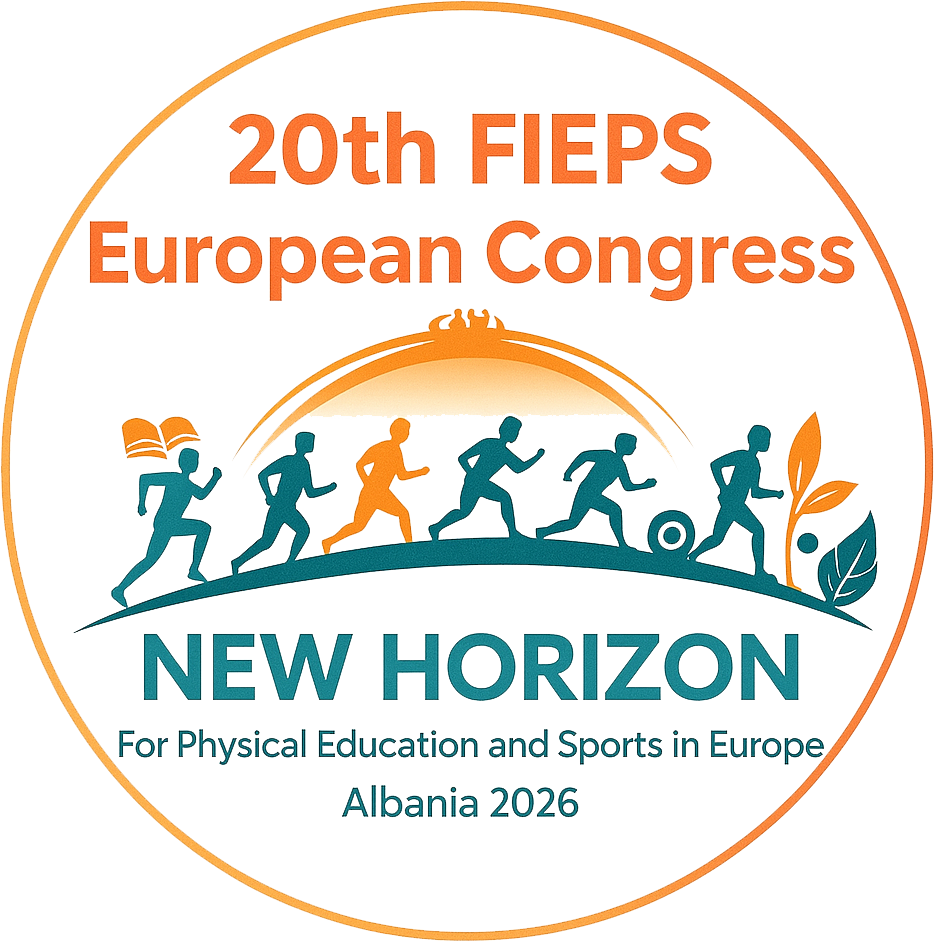
Submissions should be original work and not previously published or under review elsewhere.
TITLE OF THE PAPER IN CAPITAL LETTERS
Author 1 <sup>1</sup>, Author 2 <sup>2</sup>
<sup>1</sup> Institution / University Name, City, Country
<sup>2</sup> Institution / University Name, City, Country
Corresponding author: email@domain.com
Abstract
A brief summary (300–400 words) including purpose, methodology, results, and main conclusions.
Keywords: sport, physical education, health, youth, fitness
References
[APA 7th edition format]
Submissions should be original work and not previously published or under review elsewhere.
TITLE OF THE PAPER IN CAPITAL LETTERS
Author 1 <sup>1</sup>, Author 2 <sup>2</sup>
<sup>1</sup> Institution / University Name, City, Country
<sup>2</sup> Institution / University Name, City, Country
Corresponding author: email@domain.com
Abstract
A brief summary (300–400 words) including purpose, methodology, results, and main conclusions.
Keywords: sport, physical education, health, youth, fitness
References
[APA 7th edition format]

EJHSS – The European Journal of Health & Science in Sports
(ISSN Print: 2313-3767; ISSN Online: 2789-0260)
EJHSS is a peer-reviewed international journal indexed in Scilit since 2021. The journal publishes original research articles, reviews, and applied studies related to physical education, sport sciences, health, recreation, and human performance.
Manuscripts submitted to EJHSS must not be under consideration elsewhere and should adhere strictly to the following submission requirements.
TITLE OF THE MANUSCRIPT (IN CAPITAL LETTERS)
Author 1 <sup>1</sup>, Author 2 <sup>2</sup>
<sup>1</sup> Institution / University Name, City, Country
<sup>2</sup> Institution / University Name, City, Country
Corresponding author: email@domain.com
Abstract
Provide a concise summary (approx. 3,500 characters) highlighting the background, purpose, methods, major results, and conclusions of the study.
Keywords: physical education, sport science, health promotion, exercise, well-being
References
[APA 7th edition format]
EJHSS – The European Journal of Health & Science in Sports
(ISSN Print: 2313-3767; ISSN Online: 2789-0260)
EJHSS is a peer-reviewed international journal indexed in Scilit since 2021. The journal publishes original research articles, reviews, and applied studies related to physical education, sport sciences, health, recreation, and human performance.
Manuscripts submitted to EJHSS must not be under consideration elsewhere and should adhere strictly to the following submission requirements.
TITLE OF THE MANUSCRIPT (IN CAPITAL LETTERS)
Author 1 <sup>1</sup>, Author 2 <sup>2</sup>
<sup>1</sup> Institution / University Name, City, Country
<sup>2</sup> Institution / University Name, City, Country
Corresponding author: email@domain.com
Abstract
Provide a concise summary (approx. 3,500 characters) highlighting the background, purpose, methods, major results, and conclusions of the study.
Keywords: physical education, sport science, health promotion, exercise, well-being
References
[APA 7th edition format]

The abstract must be written in English.
Length: 300–400 words (excluding title, authors, and affiliations).
Font: Times New Roman, 12 pt, single-spaced.
Use clear scientific language and check spelling and grammar carefully.
Each abstract should clearly present: Introduction, Methods, Results, and Discussion.
All accepted abstracts will be published in the Book of Abstracts (with ISBN).
Title Page – Written in CAPITAL LETTERS, centered, bold.
Authors and Affiliations – Full names of all authors followed by institutional affiliation(s) and country. The presenting author should be underlined.
Abstract Text – 300–400 words structured as follows:
Introduction – Brief background and purpose of the study.
Methods – Description of participants, instruments, and procedures.
Results – Main findings, including statistical outcomes if applicable.
Discussion/Conclusions – Interpretation of the results and their significance.
Keywords – 4–5 keywords separated by commas.
TITLE OF THE PAPER IN CAPITAL LETTERS
Author 1 <sup>1</sup>, Author 2 <sup>2</sup>, Author 3 <sup>1</sup>
<sup>1</sup> Institution / University Name, City, Country
<sup>2</sup> Institution / University Name, City, Country
Presenting author: email@domain.com
Abstract
Introduction: Briefly describe the background, aim, or research question. Methods: Outline the methodology, participants, instruments, and analysis techniques used. Results: Summarize the most relevant findings. Include data or statistical indicators when available. Discussion: Highlight key implications, conclusions, or practical applications of the results.
Keywords: physical education, sport science, health promotion, training, well-being
The abstract must be written in English.
Length: 300–400 words (excluding title, authors, and affiliations).
Font: Times New Roman, 12 pt, single-spaced.
Use clear scientific language and check spelling and grammar carefully.
Each abstract should clearly present: Introduction, Methods, Results, and Discussion.
All accepted abstracts will be published in the Book of Abstracts (with ISBN).
Title Page – Written in CAPITAL LETTERS, centered, bold.
Authors and Affiliations – Full names of all authors followed by institutional affiliation(s) and country. The presenting author should be underlined.
Abstract Text – 300–400 words structured as follows:
Introduction – Brief background and purpose of the study.
Methods – Description of participants, instruments, and procedures.
Results – Main findings, including statistical outcomes if applicable.
Discussion/Conclusions – Interpretation of the results and their significance.
Keywords – 4–5 keywords separated by commas.
TITLE OF THE PAPER IN CAPITAL LETTERS
Author 1 <sup>1</sup>, Author 2 <sup>2</sup>, Author 3 <sup>1</sup>
<sup>1</sup> Institution / University Name, City, Country
<sup>2</sup> Institution / University Name, City, Country
Presenting author: email@domain.com
Abstract
Introduction: Briefly describe the background, aim, or research question. Methods: Outline the methodology, participants, instruments, and analysis techniques used. Results: Summarize the most relevant findings. Include data or statistical indicators when available. Discussion: Highlight key implications, conclusions, or practical applications of the results.
Keywords: physical education, sport science, health promotion, training, well-being
